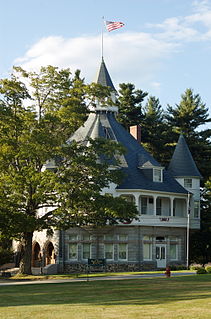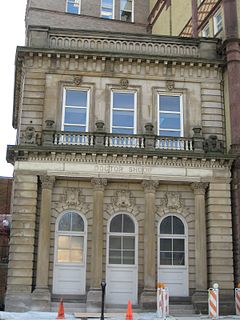
The World's Columbian Exposition was a world's fair held in Chicago in 1893 to celebrate the 400th anniversary of Christopher Columbus' arrival in the New World in 1492. The centerpiece of the Fair, held in Jackson Park, was a large water pool representing the voyage Columbus took to the New World. Chicago had won the right to host the fair over several other cities, including New York City, Washington, D.C., and St. Louis. The exposition was an influential social and cultural event and had a profound effect on architecture, sanitation, the arts, Chicago's self-image, and American industrial optimism.

Johnson Wax Headquarters is the world headquarters and administration building of S. C. Johnson & Son in Racine, Wisconsin. Designed by American architect Frank Lloyd Wright for the company's president, Herbert F. "Hib" Johnson, the building was constructed from 1936 to 1939. Its distinctive "lily pad" columns and other innovations revived Wright's career at a point when he was losing influence. Also known as the Johnson Wax Administration Building, it and the nearby 14-story Johnson Wax Research Tower were designated as a National Historic Landmark in 1976 as Administration Building and Research Tower, S.C. Johnson and Son.

Little Norway was a living museum of a Norwegian village located in Blue Mounds, Wisconsin. Little Norway consisted of a fully restored farm dating to the mid-19th century. It is listed on the National Register of Historic Places.

The White Building, also known as the Heberling Building, is located in the city of Bloomington, Illinois, United States. Located along Bloomington's East Douglas Street, the building was added to the National Register of Historic Places in June 1994 and represents one of the better examples of Commercial style architecture still extant in the city. It was built by Bloomington resident Samuel R. White in 1894–1895 to house his furniture sales company. By 1903 the Heberling Brothers pharmacy and their associated businesses occupied most of the building and the White company had moved its facilities to a nearby location. The White Building is a five-story red brick building which is elaborately windowed and has a three-story connected extension to its west which probably predates it.

The Maine State Building is a historic building on Preservation Way, part of the Poland Springs resort complex in South Poland, Maine. It was built in 1893 at the Columbian Exposition in Chicago. Designed by Chicago architect Charles Sumner Frost, a Lewiston, Maine native and MIT graduate, the building was constructed of granite with a slate roof. All the materials were from Maine and crafted by craftsmen and companies from Maine. At the fair, the building was filled with displays about the State of Maine.

This is a list of the National Register of Historic Places listings in Racine County, Wisconsin. It is intended to provide a comprehensive listing of entries in the National Register of Historic Places that are located in Racine County, Wisconsin. The locations of National Register properties for which the latitude and longitude coordinates are included below may be seen in a map.

A director's chair is a lightweight chair that folds side-to-side with a scissors action. The seat and back are made of canvas or a similar strong fabric which bears the user's full weight and can be folded; the frame is made of wood, or sometimes metal or plastic. The seat and scissors members work together to support and distribute the sitter's weight so that the seat is comfortably taut. The back is usually low and the chair usually has armrests. The stereotypical image of a movie director on location includes one of these chairs, hence the name. Victor Papanek describes this chair as an excellent design in his book Design for the Real World as it is simple and ideally suited to its function. The design goes back to coffer-makers' chairs of the 15th century and eventually to the Roman curule chair.

The Metal Office Furniture Company (Steelcase) Plants No. 2 and 3 are historic manufacturing plants located at 401 Hall Street SW in Grand Rapids, Michigan.

Charles Sumner Frost was an American architect. He is best known as the architect of Navy Pier and for designing over 100 buildings for the Chicago and North Western Railway.

Mitchell-Lewis Motor Company was founded in 1900 in Racine, Wisconsin, as a motorcycle maker spin-off from the wagon maker Mitchell & Lewis Company Ltd. The company began manufacturing automobiles in 1903. The wagon business and auto companies were combined into Mitchell-Lewis Motor Co. in 1910. The Mitchell car brand produced automobiles from 1903 to 1923.

The Old Main Street Historic District in Racine, Wisconsin is an area including a section of Main Street and which is roughly bounded by Second St., Lake Ave., Fifth St., and Wisconsin Ave. It is a 17-acre (6.9 ha) area with elements dating back to 1847. It was listed on the National Register of Historic Places in 1987.

The Montgomery Ward Company Complex is the former national headquarters of Montgomery Ward, the United States' oldest mail order firm. The property is located along the North Branch of the Chicago River at 618 W. Chicago Avenue in Near North Side, Chicago, Illinois. It was listed on the National Register of Historic Places and as a National Historic Landmark on June 2, 1978.

The Florida and Third Industrial Historic District is a group of multistory industrial lofts built from 1891 to 1928 near the Soo Line rail-yard in Milwaukee, Wisconsin, United States. It was added to the National Register of Historic Places in 2008.

The Thomas Driver and Sons Manufacturing Company is a complex of two historic factory buildings in downtown Racine, Wisconsin. The Thomas Driver and Sons manufacturing company itself was a manufacturer of sash windows and doors that was first established in 1867. The buildings, located at 134 South Main Street and 214 State Street, are on opposite sides of Second Street. The site was added to the National Register of Historic Places on July 14, 2004.

The Mitchell Lewis Building is a historic building in Racine, Wisconsin, and a former office building and automobile factory for the Mitchell Motor Company. Designed by the local architectural firm of Guilbert and Funston, it was built in 1910 at 815 Eighth Street, alongside the Chicago and North Western railroad track. After the Mitchell company went out of business in 1923, the factory was used by Nash Motors until 1929, when it was sold to the J.I. Case company, which used it as a warehouse. Later owned by Massey-Harris, it was used to build tanks during World War II. In 1960, the building was acquired by Jacobsen Manufacturing, a subsidiary of Textron, which closed the factory on June 29, 2001. Madison-based firm Gorman and Company, also responsible for the Belle Harbor lofts conversion in Racine, purchased the vacant building and converted it into apartment lofts, which opened October 13, 2004. The building was added to the National Register of Historic Places the following year.

The Shoop Building is a historic office building in downtown Racine, Wisconsin, USA. Located next to the Root River at 215 State Street and 222 Main Street, its six-story height and contrast of Cream City brick and red sandstone make it a distinctive part of Racine's skyline. Constructed in stages between 1893 and 1902, the main part of the building was designed by local architect James Gilbert Chandler.

The Vincent-McCall Company Building, now the VMC Lofts, is located in Kenosha, Wisconsin.

The Klingman Lofts is a former industrial building that has been converted to residential use, located at 400 Ionia Avenue SW, in Grand Rapids, Michigan. It was built in stages, beginning in 1895, as a furniture factory, and was formerly known as the Central Furniture Company Factory and the H.E. Shaw Furniture Company Factory. It was listed on the National Register of Historic Places in 2013. The building was renovated into apartment space in 2015.
The Horlick Malted Milk Company Industrial Complex is a historic factory complex in Racine, Wisconsin, where Horlicks malted milk was produced. Four buildings within the complex are listed: the castle-like Gothic Revival-style factory blocks begun in 1882 and 1902, the 1910 engine room building, and the 1916 garage.

Cyril Colnik was a master metalsmith from Austria. He emigrated to the United States to attend the 1893 World's Columbian Exposition in Chicago where he won the gold medal for his entry to the exposition. He was a pacifist and instead of making armaments for World War I, he closed his business.



















